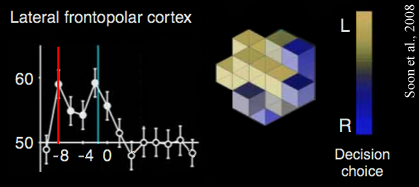Determinants of Free Decisions
I recently went over “Unconscious determinants of free decisions in the human brain” for a presentation during our weekly lab meeting. The article’s first author is Chun Siong Soon, who is an old friend from time he spent at Dartmouth several years ago. I also saw the senior author, John-Dylan Haynes, present the research at the Human Brain Mapping conference last year in Chicago. It has been interesting to see the evolution of this work, and fascinating to see the controversy surrounding it.

Using a free response task Soon et al. found that areas of frontopolar cortex and precuneus have activity that encodes which button a subject will press up to eight seconds before they actually push it (see above graph, red line). They also found that SMA and pre-SMA have activity that encodes when the subject will press a button up to five seconds before it actually happened. The most interesting timing number is that the subjects only became consciously aware of their motor intention within the last second of actually pressing the button. The logical conclusion? There was no conscious will involved – unconscious processing fully determined the outcome and timing of the button press before the conscious mind became aware of what was about to happen.
An important aspect of these results is that there was no overall increase in activity within the cortical regions. Instead, the authors used machine learning techniques to look at the spatial pattern of activity across a local ‘spotlight’ of voxels. For example, in frontopolar cortex one configuration of voxels indicated a future right button press while a slightly different configuration of activity indicated a future left button press (see above cube figure).
I tend to think of pattern recognition like listening to a symphony piece. Using our traditional approach we will only listen to one instrument at a time. We can then construct a map of what note each instrument was playing according to where they sat on stage. Using pattern recognition techniques we can begin listening to more instruments at once. We can now attend to small groups of strings or percussion to hear what the overall sound is like. This is an oversimplified view of pattern recognition, but it is appropriate.
In my view the key finding from this paper is not that the authors were able to predict the future button press with ~60% accuracy. A number of methodological factors impact the conclusions from the data – the paper says less about free will and perhaps much more about the range of cognitive operations necessary to freely press a button. Rather, I believe the key finding is that we are losing a large amount of information by limiting our search to individual voxel intensity values. By incorporating the spatial pattern of activity into our analyses we can increase the total amount of information available for hypothesis testing, which is always a desirable goal in science.
* Soon CS, Brass M, Heinze HJ, Haynes JD. (2008). Unconscious determinants of free decisions in the human brain. Nature Neuroscience,11(5):543-545.

Leave a Reply
You must be logged in to post a comment.